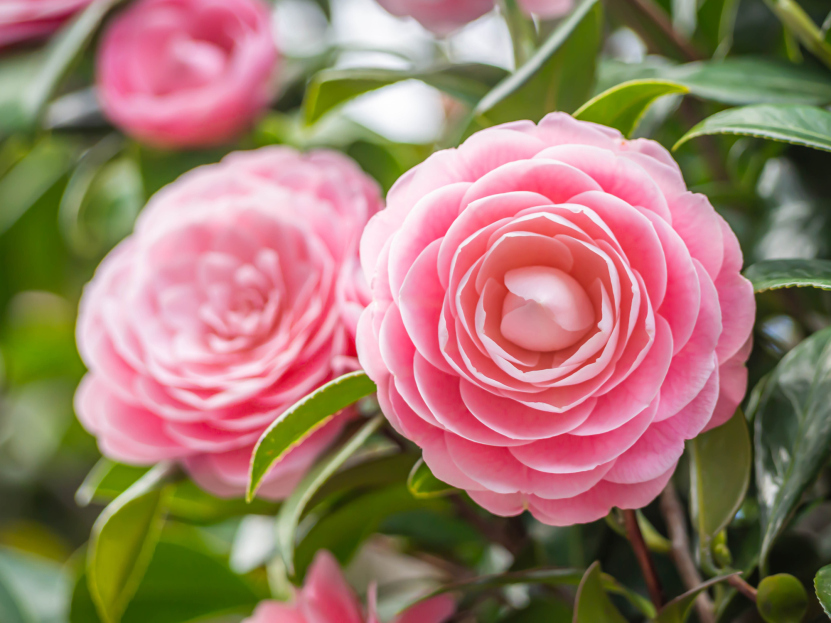
Camellias are prized for their elegant, showy flowers and glossy, evergreen foliage. Whether grown indoors or outdoors, these beautiful plants can bring a touch of sophistication to your home or garden. Known for their large, colorful blooms, which come in shades of pink, red, and white, camellias can be a bit particular about their care, but with the right conditions, they thrive and bloom year after year. Here’s everything you need to know about caring for a Camellia houseplant.
Camellias prefer bright, indirect light. While they can tolerate some direct sunlight, especially in the early morning or late afternoon, it’s best to avoid placing them in areas where they’ll be exposed to harsh midday sun. Too much direct sunlight can scorch their leaves, leading to brown spots and overall stress.
If you’re growing a Camellia indoors, place it near a window with filtered light, such as an east or north-facing window. If your home doesn’t get enough natural light, you can supplement with a grow light to ensure your Camellia receives the light it needs to thrive.
One of the most important aspects of Camellia care is watering. These plants prefer consistently moist soil, but they don’t like to sit in water. It’s essential to keep the soil evenly moist without allowing it to become soggy, as too much moisture can lead to root rot.
To water your Camellia, check the top inch of soil. If it feels dry, it’s time to water. When you do water, be sure to water deeply, allowing the water to reach the root system. Always ensure that your pot has good drainage to allow excess water to escape.
During the winter months, when the plant is less actively growing, you can reduce watering slightly. However, don’t let the soil dry out completely. Camellias can be sensitive to dry conditions, especially during their blooming period, so consistent moisture is key.
Camellias prefer acidic, well-draining soil. A mix designed for azaleas or rhododendrons is a good choice, as it provides the acidity and drainage that Camellias need. You can also amend regular potting soil with peat moss or pine bark to create a more acidic environment.
When choosing a pot for your Camellia, make sure it has drainage holes to prevent water from pooling at the bottom. This will help prevent root rot and keep your plant healthy. Camellias don’t like to be root-bound, so be sure to repot your plant every couple of years or when it outgrows its current container. When repotting, choose a pot that is only slightly larger than the current one to avoid overwatering the roots.
Camellias prefer moderate temperatures, typically between 60°F and 70°F (15°C to 21°C). They can tolerate slightly cooler temperatures but should be kept away from drafts, which can stress the plant. Avoid placing your Camellia near heating vents, air conditioners, or cold windows, as these can cause temperature fluctuations that may harm the plant.
In terms of humidity, Camellias appreciate a bit more moisture in the air, especially during the winter when indoor air can become dry. To increase humidity, you can mist the leaves occasionally or place a humidity tray near the plant. However, avoid misting the flowers, as this can cause them to rot.
To keep your Camellia healthy and encourage vibrant blooms, it’s important to fertilize it during the growing season. Use a balanced, slow-release fertilizer that is designed for acid-loving plants, such as azaleas or rhododendrons. Apply the fertilizer in the spring, just before new growth begins, and again in the summer if necessary.
Avoid fertilizing during the fall and winter months, as the plant is in a resting phase and doesn’t need extra nutrients. Over-fertilizing can lead to excessive leaf growth at the expense of flowers, so always follow the instructions on the fertilizer package.
Pruning Camellias is generally not necessary unless you want to shape the plant or remove dead or damaged growth. You can prune your Camellia after it has finished blooming, typically in late winter or early spring. Use clean, sharp pruning shears to remove any dead or leggy stems, cutting just above a leaf node to encourage new growth.
Deadheading spent flowers is also recommended to keep your Camellia looking tidy and to prevent the plant from putting energy into seed production. Simply pinch off the faded blooms at their base.
Camellias are relatively pest-resistant, but they can occasionally attract aphids, scale insects, or spider mites. If you notice small pests on the leaves or a sticky residue, inspect the plant closely. You can treat pests by wiping the leaves with a damp cloth or using insecticidal soap or neem oil.
Camellias can also be susceptible to fungal diseases, such as powdery mildew or root rot. To prevent fungal issues, avoid overhead watering, as wet leaves can encourage fungal growth. Make sure the plant has good air circulation and avoid placing it in overly humid environments. If you notice any signs of disease, such as yellowing leaves or wilting, treat the plant with a fungicide.
During the winter months, Camellias may enter a dormant phase, especially if they are grown indoors. While the plant may not require as much water or fertilizer during this time, it’s still important to maintain consistent care. Keep the plant in a cool, well-lit area, and water it sparingly when the top inch of soil becomes dry.
If your Camellia is blooming during the winter, be sure to keep it in a location where it can receive adequate light, as this will help the flowers last longer.
Camellias are non-toxic to both cats and dogs, making them a safe option for households with pets. However, as with any plant, it’s a good idea to keep it out of reach of curious pets to prevent them from chewing on the leaves or flowers.